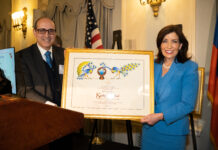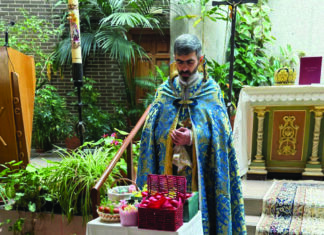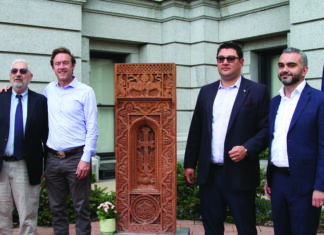By Nancy Kalajian
Special to the Mirror-Spectator
WASHINGTON — An inspiring Divine Liturgy at the Shrine of the Immaculate Conception in Washington, DC was just ending with an angelic-sounding choir of about 200 who represented many Armenian churches from around the US , and a multitude of clergy preceding the Catholicoi in a procession down the Shrine’s lengthy center aisle. Turning the corner, Catholicos Aram I of the Great House of Cilicia, seemed to be blessing those close enough to touch with his cross, and I was no exception. Then I saw Karekin II, Supreme Patriarch and Catholicos of all Armenians, also giving blessings as he walked in the procession. Suddenly, it dawned on me that this was such a rare occasion, to be in the presence of two Catholicoi and that I should also try to be blessed by Karekin II so I followed in the procession, seeming like a lamb following its mother for nurturing, each step getting a little closer to his golden cloak. Within an instant of his cross touching my forehead, tears suddenly welled up in my eyes. Seeing how moved I was, other nearby gave a nod, smile or hug in harmony with the uplifting experience we had all shared. This, I felt, was a time to cherish — that here Armenians were united, seemingly free from political divisions, in this special house of worship in our nation’s capital, that this was a sign for continued good things to come.
So it was that early in May, numerous Armenians came to Washington from Paris, Los Angeles, Long Island, Detroit, Racine, Austin and Watertown, as well as countless other locales, to commemorate the 100th anniversary of the Armenian Genocide. Organized through the National Commemoration of the Armenian Genocide Centennial, the Marriott Marquis Hotel at the Convention Center was a hubbub of Armenian-related activity, providing accommodations for many guests, a welcome desk with information on presentations and tickets for certain commemorative events, and the location for facilitation of Hye-sightings in the spacious lobby, elevators and restaurants.
During three days, opportunities were aplenty for becoming more knowledgeable about the Genocide, through reading numerous informative panels, viewing exhibits of Armenian costumes and artifacts, watching demonstrations of Armenian music and dance, or buying books and even getting some autographed by their authors. More than 30 presentations, each often an hour in length, were given on topics ranging from Armenian poetry, the fire in Smyrna, essay contests, to volunteer opportunities in Armenia. Though I was familiar with some speakers or topics, others provided a chance to learn more. Meeting other guests attending some of the presentations made me realize how fortunate we are in the East Coast — especially Boston, New York and New Jersey — to hear from so many knowledgeable speakers and have so many resources available. One woman from the Midwest, for example, said she rarely experiences such a caliber of writers and presenters, and would have to travel many hours for such presentations.
Hands-on learning, for all ages, was also available. Though a bit hesitant at first, I gave the bird letter making, or Trchnakir, class a chance and came home with a letter, stork-adorned. Also, I painted on silk a flower in wild, bright colors, to remind me of the colors that once lit the lives of my ancestors, those I never knew but who live through family memories, thoughts and prayers.








